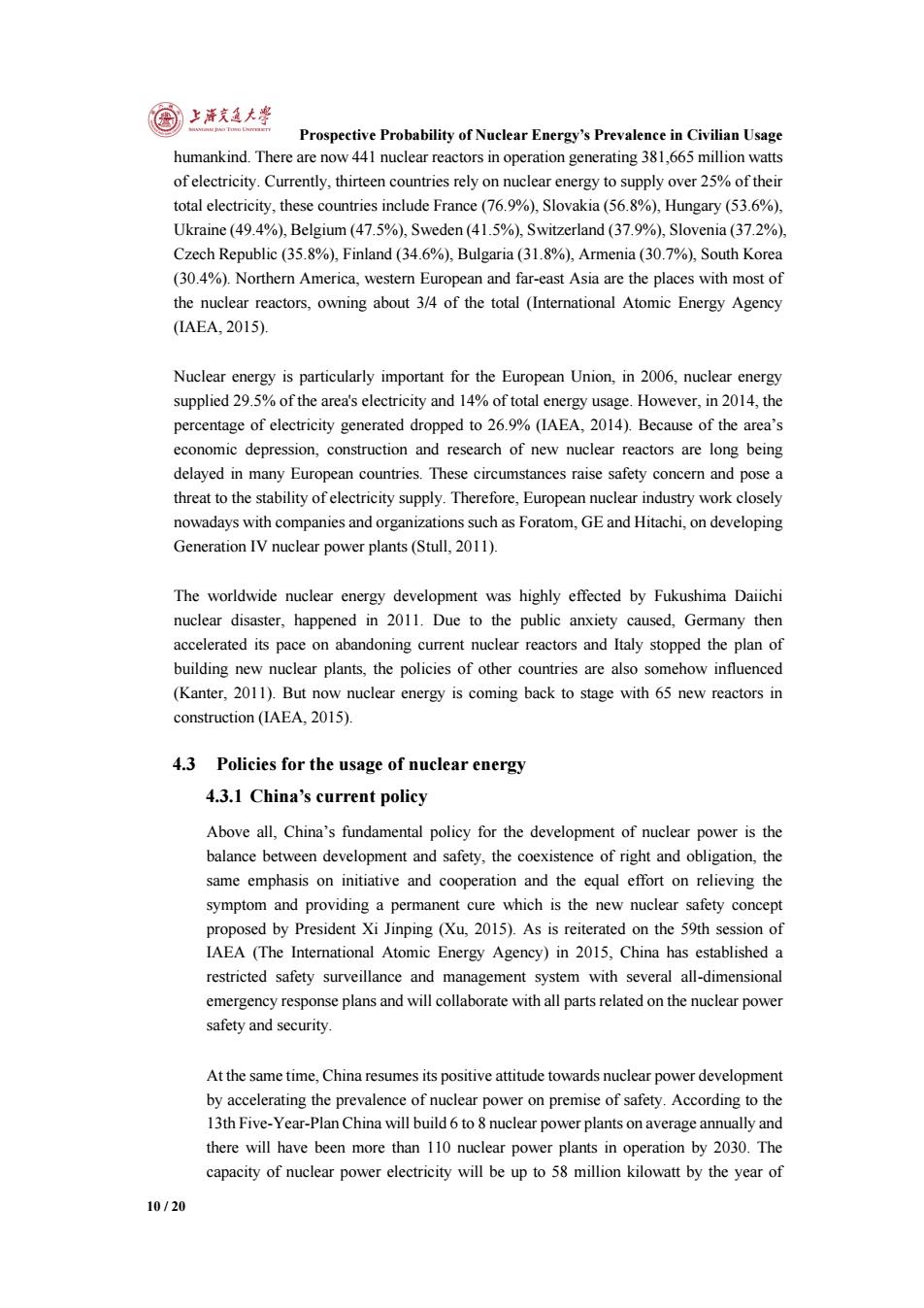正在加载图片...

上亥盈大粤 Prospective Probability of Nuclear Energy's Prevalence in Civilian Usage humankind.There are now 441 nuclear reactors in operation generating 381,665 million watts of electricity.Currently,thirteen countries rely on nuclear energy to supply over 25%of their total electricity,these countries include France (76.9%),Slovakia(56.8%),Hungary(53.6%), Ukraine(49.4%),Belgium(47.5%),Sweden(41.5%),Switzerland (37.9%),Slovenia(37.2%), Czech Republic (35.8%),Finland(34.6%),Bulgaria (31.8%),Armenia(30.7%),South Korea (30.4%).Northern America,western European and far-east Asia are the places with most of the nuclear reactors,owning about 3/4 of the total(International Atomic Energy Agency (LAEA,2015). Nuclear energy is particularly important for the European Union,in 2006,nuclear energy supplied 29.5%of the area's electricity and 14%of total energy usage.However,in 2014,the percentage of electricity generated dropped to 26.9%(IAEA,2014).Because of the area's economic depression,construction and research of new nuclear reactors are long being delayed in many European countries.These circumstances raise safety concern and pose a threat to the stability of electricity supply.Therefore,European nuclear industry work closely nowadays with companies and organizations such as Foratom,GE and Hitachi,on developing Generation IV nuclear power plants(Stull,2011). The worldwide nuclear energy development was highly effected by Fukushima Daiichi nuclear disaster,happened in 2011.Due to the public anxiety caused,Germany then accelerated its pace on abandoning current nuclear reactors and Italy stopped the plan of building new nuclear plants,the policies of other countries are also somehow influenced (Kanter,2011).But now nuclear energy is coming back to stage with 65 new reactors in construction(IAEA.2015). 4.3 Policies for the usage of nuclear energy 4.3.1 China's current policy Above all,China's fundamental policy for the development of nuclear power is the balance between development and safety,the coexistence of right and obligation,the same emphasis on initiative and cooperation and the equal effort on relieving the symptom and providing a permanent cure which is the new nuclear safety concept proposed by President Xi Jinping (Xu,2015).As is reiterated on the 59th session of IAEA (The International Atomic Energy Agency)in 2015,China has established a restricted safety surveillance and management system with several all-dimensional emergency response plans and will collaborate with all parts related on the nuclear power safety and security. At the same time,China resumes its positive attitude towards nuclear power development by accelerating the prevalence of nuclear power on premise of safety.According to the 13th Five-Year-Plan China will build 6 to 8 nuclear power plants on average annually and there will have been more than 110 nuclear power plants in operation by 2030.The capacity of nuclear power electricity will be up to 58 million kilowatt by the year of 10/20Prospective Probability of Nuclear Energy’s Prevalence in Civilian Usage 10 / 20 humankind. There are now 441 nuclear reactors in operation generating 381,665 million watts of electricity. Currently, thirteen countries rely on nuclear energy to supply over 25% of their total electricity, these countries include France (76.9%), Slovakia (56.8%), Hungary (53.6%), Ukraine (49.4%), Belgium (47.5%), Sweden (41.5%), Switzerland (37.9%), Slovenia (37.2%), Czech Republic (35.8%), Finland (34.6%), Bulgaria (31.8%), Armenia (30.7%), South Korea (30.4%). Northern America, western European and far-east Asia are the places with most of the nuclear reactors, owning about 3/4 of the total (International Atomic Energy Agency (IAEA, 2015). Nuclear energy is particularly important for the European Union, in 2006, nuclear energy supplied 29.5% of the area's electricity and 14% of total energy usage. However, in 2014, the percentage of electricity generated dropped to 26.9% (IAEA, 2014). Because of the area’s economic depression, construction and research of new nuclear reactors are long being delayed in many European countries. These circumstances raise safety concern and pose a threat to the stability of electricity supply. Therefore, European nuclear industry work closely nowadays with companies and organizations such as Foratom, GE and Hitachi, on developing Generation IV nuclear power plants (Stull, 2011). The worldwide nuclear energy development was highly effected by Fukushima Daiichi nuclear disaster, happened in 2011. Due to the public anxiety caused, Germany then accelerated its pace on abandoning current nuclear reactors and Italy stopped the plan of building new nuclear plants, the policies of other countries are also somehow influenced (Kanter, 2011). But now nuclear energy is coming back to stage with 65 new reactors in construction (IAEA, 2015). 4.3 Policies for the usage of nuclear energy 4.3.1 China’s current policy Above all, China’s fundamental policy for the development of nuclear power is the balance between development and safety, the coexistence of right and obligation, the same emphasis on initiative and cooperation and the equal effort on relieving the symptom and providing a permanent cure which is the new nuclear safety concept proposed by President Xi Jinping (Xu, 2015). As is reiterated on the 59th session of IAEA (The International Atomic Energy Agency) in 2015, China has established a restricted safety surveillance and management system with several all-dimensional emergency response plans and will collaborate with all parts related on the nuclear power safety and security. At the same time, China resumes its positive attitude towards nuclear power development by accelerating the prevalence of nuclear power on premise of safety. According to the 13th Five-Year-Plan China will build 6 to 8 nuclear power plants on average annually and there will have been more than 110 nuclear power plants in operation by 2030. The capacity of nuclear power electricity will be up to 58 million kilowatt by the year of